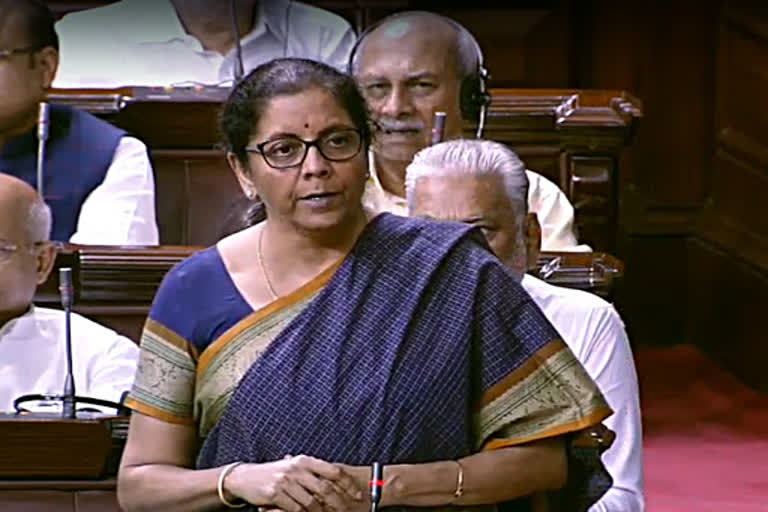New Delhi: Rajya Sabha has passed the Insolvency and Bankruptcy Code (IBC) Amendment Bill, 2019.
Finance Minister Nirmala Sitharaman on Monday told Rajya Sabha that the proposed amendments in the Insolvency and Bankruptcy Code are aimed at ensuring greater clarity in the debt resolution process.
She said the Insolvency and Bankruptcy Code Amendment Bill has been brought to remove grey areas and ensure that no interpretations which are against the original intent of the Act prevail.
The minister said four out of the eight sets of amendments being brought in are explanatory in nature.
"There is a fear that probably the original intent with which this Parliament brought Insolvency and Bankruptcy Code is probably getting diluted. We should not allow its dilution just for want of clarity," she said while moving The Insolvency and Bankruptcy Code (Amendment) Bill 2019, for consideration and passage in Rajya Sabha.
The Minister said until the Insolvency and Bankruptcy Code 2016 was brought in, the country's insolvency framework was all scattered and fragmented leading to sub-optimal realization or outcome of the legislative intent of the bill itself.
Earlier the average time taken for any resolution of insolvency was almost 4.3 years and that kind of time adds to the cost. "Nearly nine per cent resolution cost and the recovery rate was only about 26 per cent," she said.
Read More: Strong economic policy must for Himalayan states: Nirmala Sitharaman
"Within 2.5 years of this Code, we realised that there are certain areas in which for want of clarity the interpretation given by various courts or even by the National Companies Law Tribunal (NCLT) led to a very vital question, that if the legislative intent of the IBC was itself becoming weakened just for want of clarity," the Finance Minister said.
In a way, the (Insolvency and Bankruptcy) Code is being monitored through a Central Government Monitoring Committee and the amendments are being made after due consultations with stakeholder, the Finance Minister said.
She said the balance of interest of stakeholders was becoming an issue and therefore the amendments have been brought in.
Participating in the discussion on the Bill, Congress leader Kapil Sibal said while some of the amendments are salutary and the direction is right, this kind of legislation should not be decided and bulldozed through Parliament without referring the matter to a Select Committee.
He claimed that the economy was going through very difficult times with various sectors like automobile, steel, real estate and FMCG facing problems.
"The worry I have is while you solve this problem, you are going to create unemployment," Sibal said.
Citing the examples of insolvency cases involving big firms, he said, an oligopoly was being created as 4-5 major players were able to buy such companies at throwaway prices.
"This resolution is in favor of the big players who are getting the silver of this country at a throwaway price," Sibal said.
The proposed amendments to the Code are aimed at filling critical gaps in the corporate insolvency resolution framework while at the same time maximising value from resolution.
The changes in the law are aimed at timely admission of applications and timely completion of the corporate insolvency resolution process.
The bill also provides that if an application has not been admitted or rejected within 14 days by the adjudicating authority, it shall provide the reasons in writing for the same.
It provides a deadline for completion of CIRP (Corporate Insolvency Resolution Process) within an overall limit of 330 days, including litigation and other judicial processes.
The proposed amended Code is also aimed at providing greater clarity on the permissibility of corporate restructuring schemes, clarity on rights and duties of authorized representatives of voters, manner of distribution of amounts amongst financial and operational creditors and applicability of the resolution plan on all statutory authorities.
The bill provides for an explanation in the definition of "resolution plan" to clarify that a resolution plan proposing the insolvency resolution of the corporate debtor as a going concern may include the provisions for corporate restructuring, including by way of merger, amalgamation, and demerger.
This is to enable the market to come up with dynamic resolution plans in the interest of value maximisation.
It also provides that the votes of all financial creditors covered under section 21(6A) shall be cast in accordance with the decision approved by the highest voting share (more than 50 per cent) of financial creditors on present and voting basis.
This will have retrospective effect where the resolution plan has not attained finality or has been appealed against.
The bill also brings clarity saying the resolution plan shall be binding on all stakeholders including the Central Government, any State Government or local authority to whom a debt in respect of the payment of the dues may be owed.
The bill also provides clarity that the Committee of Creditors may take the decision to liquidate the corporate debtor any time after the constitution of the Committee of Creditors and before preparation of Information Memorandum.



